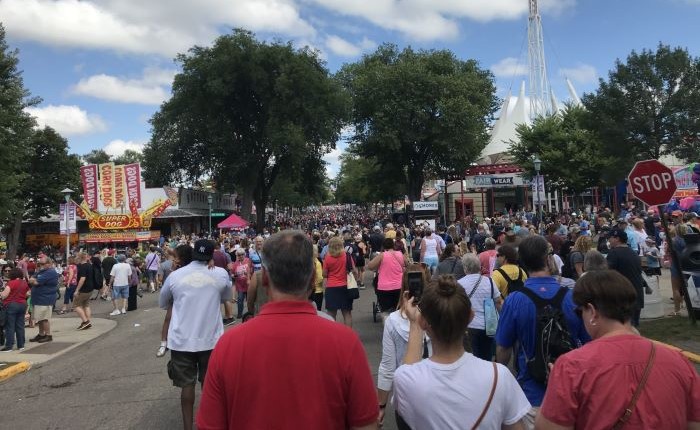Sweet Martha’s Cookies. Pronto Pups. Princess Kay’s Butter Sculpture. Any Minnesota State Fair enthusiast can easily conjure (or taste!) these iconic images from the Great Minnesota Get-Together. But today, we want to focus on some other, often more invisible (but equally iconic) elements at the State Fair that promote sustainability!
The Minnesota State Fair, boasting some of the largest numbers of attendees in state fairs across the United States, must make plans not only for vendors, markets, animals, weather and media, but also for the literal tons of materials and waste that will need to be discarded.
After a fascinating and informative interview with Maria Hayden, the Minnesota State Fair’s official spokesperson, Bellmont Partners learned all about the facts and figures around sustainability at the fair.
“This year, more than 800 bottle-recycling receptacles will be placed around the fairgrounds, ready to collect and recycle upwards of 30 tons of glass, plastic and aluminum over the course of the 2023 fair,” explained Hayden. “And for the more than 70 tons food waste, cardboard, grease, compost, co-mingling recycling and garbage, the fair has labeled receptacles throughout the grounds, with sanitation staff on duty to monitor and correct disposals to ensure waste is being appropriately diverted.”
To put it simply, this is a huge event. And so far, the measures we’ve listed are only related to people.
Animals play a quintessential role in the essence and purpose of the Minnesota State Fair. From the Miracle of Birth Center to the 4‑H Building, Pet Pavilion, Butterfly House and glimmering fish at the DNR Building, logistics around animals, and their waste, is a necessary factor in the State Fair equation.
Once again, the folks at the fair have carefully calculated sustainability into these plans. Maria shared that the state fair will separate and clean more than 3,400 tons of manure from cows, horses, sheep, goats, pigs, llamas, rabbits and other livestock of trash and non-natural materials, then transport this manure to Hastings, Minn., where it will be composted, mixed with dirt and used as fertilizer on more than 1,000 acres of farm field.
Additionally, the buildings on the grounds, many of which have historic significance, have received updates over the years to be more efficient, including the installation of energy-conserving LED bulbs and incorporating green building features into some new construction. The fair has also implemented onsite storm water management techniques using new infiltration and native plantings.
These operational efforts undoubtedly make an enormous impact, yet the Minnesota State Fair does not stop there. This year, the Eco Experience will be occurring all twelve days of the Fair. Air, Land, Water and Climate exhibits and the Sustainability Stage — outreach efforts supported by the Minnesota Pollution Control Agency — make this the largest environmental event of its kind, nationally, in the last two decades. Fairgoers can learn about hands-on, actionable steps they can take to make their home, commute, and lifestyle choices more sustainable for Minnesota and the world.
So, what can you do in 2023 to enjoy the Minnesota State Fair sustainably?
- Bring a reusable water bottle. Use refillable water stations located all over the grounds. These stations are labeled on this year’s map!
- Sort your trash properly. Use the labels on waste and recycling receptacles to properly dispose of food waste, packaging, and more, so that it can be accurately discarded or recycled.
- Save your souvenir cup and Fun Card! Purchase one cup and one Fun Card (the new paperless ticket system for the Midway and Kidway!) this year and use it next year (and the years after!)
- Take advantage of the numerous public transportation options across the metro or even consider riding your bike!
It’s a Great Minnesota Get-Together, but let’s make it a “Green” one, too!

